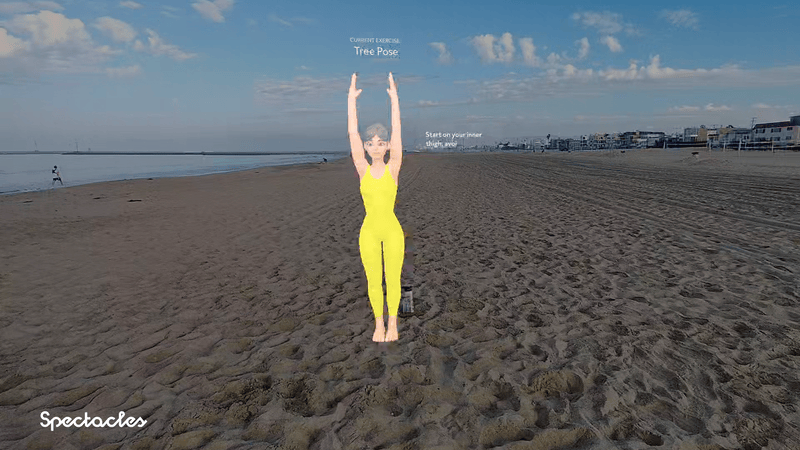Snap OS now has Synth Riders, Star Wars, and Avatar: The Last Airbender minigames, which will be available on the consumer Snap Specs at launch.
What Are Snap OS, Snap Spectacles, And Snap Specs?
If you’re unfamiliar, the current Snap Spectacles are $99/month AR glasses for developers ($50/month if they’re students), intended to let them develop apps for the Specs consumer product the company behind Snapchat intends to ship in 2026.
Spectacles have a 46° diagonal field of view, angular resolution comparable to Apple Vision Pro, relatively limited computing power, and a built-in battery life of just 45 minutes. They’re also the bulkiest AR device in “glasses” form factor we’ve seen yet, weighing 226 grams. That’s almost 5 times as heavy as Ray-Ban Meta glasses, for an admittedly entirely unfair comparison.
But Snap CEO Evan Spiegel claims that the consumer Specs will have “a much smaller form factor, at a fraction of the weight, with a ton more capability”, while running all the same apps developed so far.
As such, what’s arguably more important to keep track of here is Snap OS, not the developer kit hardware.
Snap OS is relatively unique. While on an underlying level it’s Android-based, you can’t install APKs on it, and thus developers can’t run native code or use third-party engines like Unity. Instead, they build sandboxed “Lenses”, the company’s name for apps, using the Lens Studio software for Windows and macOS.
In Lens Studio, developers use JavaScript or TypeScript to interact with high-level APIs, while the operating system itself handles the low-level core tech like rendering and core interactions. This has many of the same advantages as the Shared Space of Apple’s visionOS: near-instant app launches, interaction consistency, and easy implementation of shared multi-user experiences without friction. It even allows the Spectacles mobile app to be used as a spectator view for almost any Lens.
Snap OS doesn’t support multitasking, but this is more likely a limitation of the current hardware than the operating system itself.
So far, Snap’s focus with its AR glasses platform has mostly been on adding new developer capabilities, and at Lens Fest 2025 this week released a range of new APIs. These tools have been used by dozens of enthusiastic AR developers to build AR Lenses.
With the release of Snap OS 2.0 the company has also started building out consumer-focused features, like a Travel Mode, improved Browser with WebXR support, and Gallery app.
And at Lens Fest, Snap also announced the launch of Lenses from major developers and brands, including Star Wars and Avatar: The Last Airbender.
Snap OS Gets In-App Payments, Permission Alerts, UI Kit, Mobile Kit, EyeConnect
Snap OS now has in-app payments, a UI Kit, a permissions system for raw camera access, EyeConnect automatic colocation, and more.

Snap has repeatedly confirmed that all current Lenses will run on the consumer Specs AR glasses coming in 2026, so all this content should be available at launch.
Synth Riders
Synth Riders from Kluge Interactive is a popular XR rhythm game available on Meta Quest, Apple Vision Pro, PlayStation VR2 and PC VR headsets.
Last month Snap announced that a ported version was coming to Snap OS, and it’s out now.
Footage recorded by UploadVR at Snap London. NOTE: Spectacles records a much wider field of view than it can display. In reality, you can essentially only see virtual content when looking directly at it.
I went hands-on with Synth Riders on Snap Spectacles last month. Unfortunately, Spectacles can only record for 30 seconds, but you can still get an idea of how the game transfers from VR/MR headsets to AR glasses.
(As an aside, note how the virtual object emits light onto the furniture below it. That’s because Snap OS provides a continuous scene mesh to Lenses, letting them naturally fit in with real world geometry.)
Star Wars: Holocron Histories
Star Wars: Holocron Histories is the latest project from ILM Immersive, the XR development wing of Industrial Light & Magic.
The extremely brief clip shown at Lens Fest 2025 when announcing Star Wars: Holocron Histories.
Snap says the Lens sees you “guided by a former student of the Force”, and has three experiences: an encounter between Jedi and Sith, a cautionary tale from the Nightsisters, and an inspirational tale about the Guardians of the Whills.
It’s the latest in a long catalog of ILM Immersive Star Wars content that includes Vader Immortal on Quest and PlayStation VR, Tales from the Galaxy’s Edge on Quest and PlayStation VR2, and the new Star Wars: Beyond Victory mixed reality game for Quest 3.
Avatar: The Last Airbender![]()
Snap says the Avatar: The Last Airbender Lens lets you train alongside Aang, using head movement and hand gestures to propel air forward and knock down targets.
Figma & Tripadvisor “Coming Soon”
Snap says Lenses from Figma and Tripadvisor are “coming soon”.
There are no specific details yet on what exactly these Lenses will be.
A Building Content Library
With promised true AR, like the Spectacles developer kit, but in “a much smaller form factor, at a fraction of the weight, with a ton more capability”, as CEO Evan Spiegel claims, Snap Specs are likely to be priced in the thousands of dollars, and the company will have to convince potential buyers that the content available justifies the price.


Yoga (left) and Translation (right)
With the Star Wars, Avatar: The Last Airbender, and Synth Riders minigames joining existing third-party titles like Lego Bricktacular, and new and updated first-party ones like Yoga and Translation, Snap seems to be steadily building out the Snap OS content library ahead of the launch next year.
